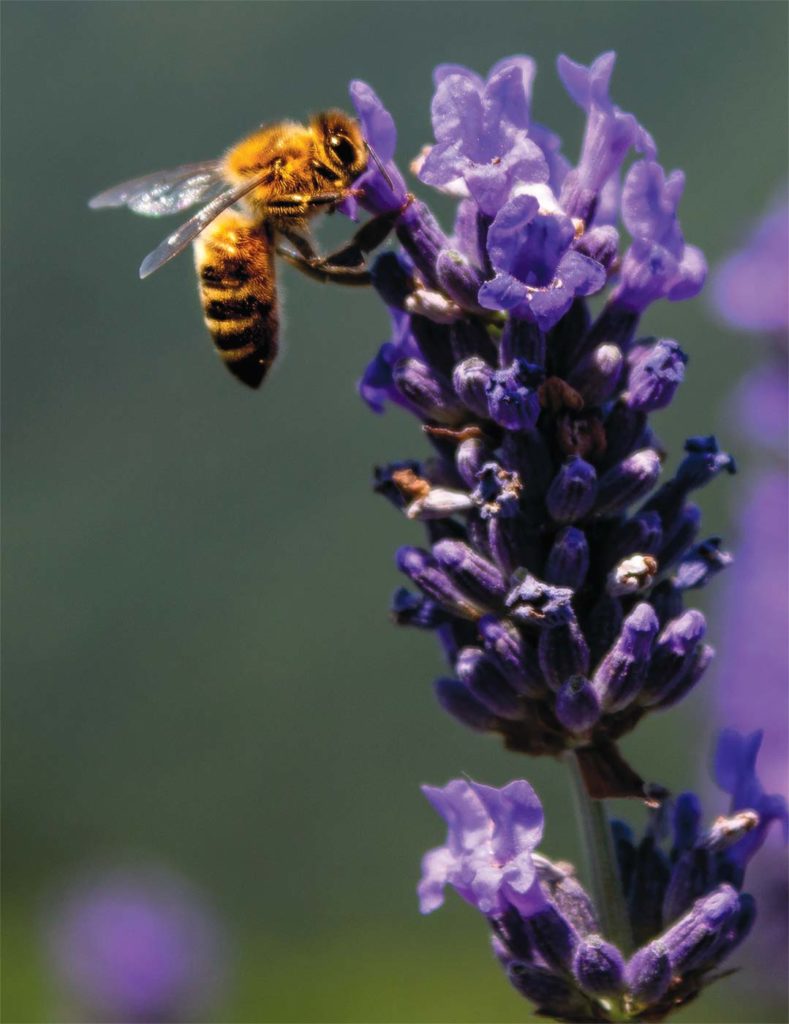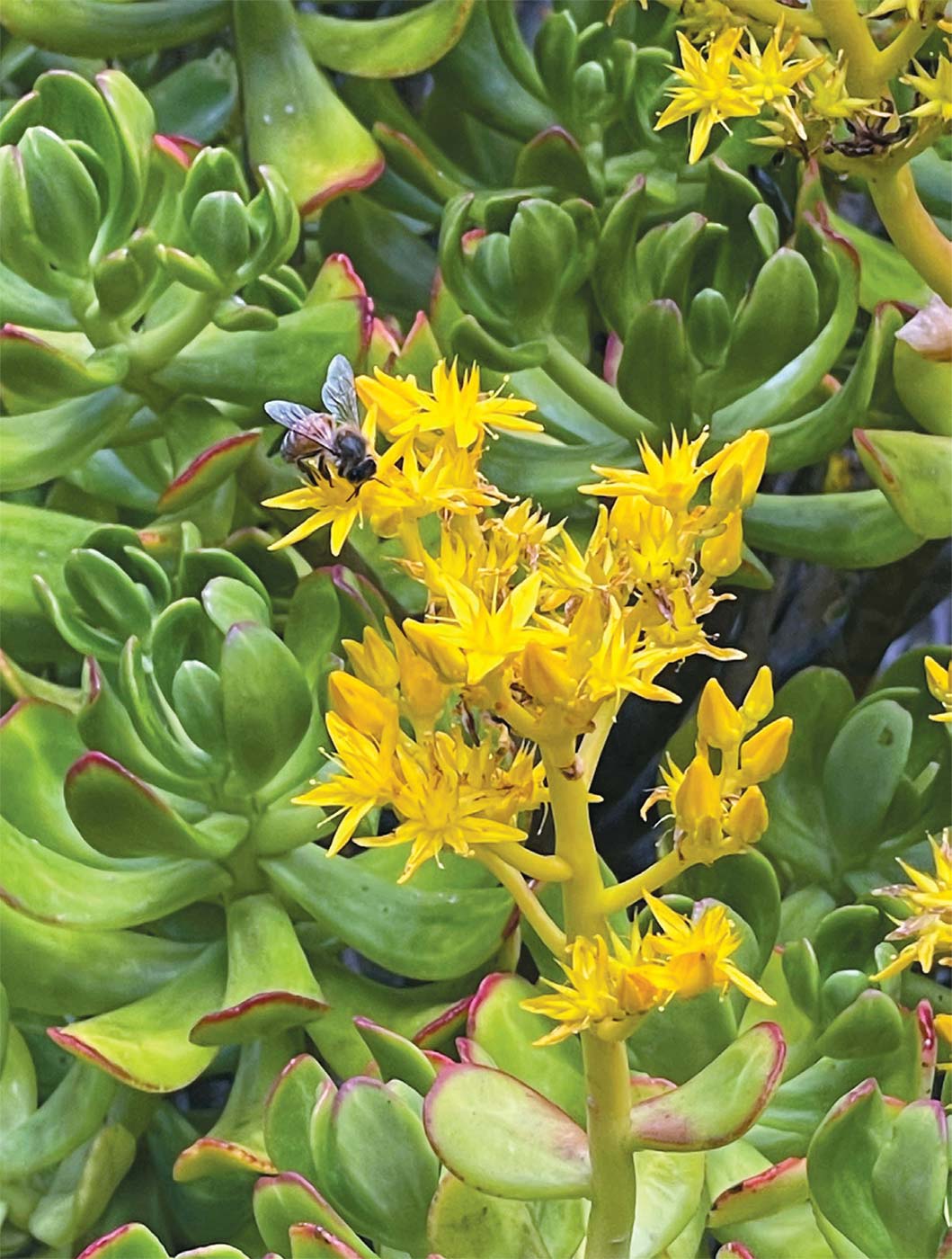
How gardeners can create sanctuary for pollinator insects
When bees and butterflies buzz by the Homeless Garden Project in Santa Cruz, it must look like a heavenly snack bar and sanctuary, all in one.
Farm manager Ella Fleming knows that HGP’s organic operation depends on pollinating insects to ensure decent crop yields so that it can keep its farmstand well stocked. The farm grows more than 50 varieties of flowers—which are sold as cut flowers at the stand—and also lure precious pollinators. Native flowers and shrubs, butterfly bush, marigolds, dahlias, lavender, snapdragons and Shasta daisies provide food and shelter for both native insects and European honeybees on the property.
But most importantly, Fleming says, “As an organic farm, we never spray any chemicals that may interfere with pollinators’ health or life cycle.”
Pollinator-friendly gardening is now a trend in sustainable circles, creating an environment that encourages bees, butterflies and other insects to come in, get some nectar and stay a while. It’s not just a fad, but a movement with serious intent: to provide safe space for these beneficial insects, many of which have been impacted by habitat destruction and pesticide use.
Home gardeners, urban garden keepers and organic farmers can help rescue pollinators— simply by providing a little oasis for them that includes nectar plants, hiding places, shelter and a shallow water source.



Dr. Stacy Philpott of the UC Santa Cruz Center for Agroecology has made urban gardens her focus in an ongoing research project. Philpott, who spoke about her work in conjunction with a pollinator exhibit at the Santa Cruz Museum of Natural History, says she has been intrigued by urban gardens since the late 1990s.
Since 2013, she has headed a team that gathers data from 25 gardens, including HGP, Aptos Community Garden and Santa Clara University. Philpott’s findings bolster the idea that gardens can be important places of refuge for pollinators, and that pollinators contribute to the biodiversity of gardens.
When we think of bees, it’s usually the European honeybee that comes to mind. But there are hundreds of native bees in California, which come in all different shapes, sizes and hues. Some come in brilliant colors; others are shiny black, and many are fuzzy or hairy, like bumblebees. It’s those hairs that help them pass pollen from flower to flower.
And that spreading of pollen is all important. Pollination is key to most plants’ ability to form seed-bearing fruits—so if we don’t have pollinators, say goodbye to squash, peppers, tomatoes, avocados, plums, pistachios, melons and a whole lot of other good things to eat. Plenty of other pollinators are out there as well, including beetles, flies and hummingbirds.
“About 35% of our food crops rely on insect pollination, and all sorts of native plants cannot survive without insect pollinators,” says Philpott. “So it is essential for our well-being and for the well-being of all of the earth’s biodiversity to do our best to understand and conserve pollinators. Gardens are one place where humans and pollinators can both thrive, even in sprawling cities.”
Philpott has a special interest in native bees, and confesses that she has a special affection for the ultra-green sweat bee, Agapostemon texanus.
“This is my favorite because it is so unique with both the metallic green head and thorax, and more ‘bee-like’ yellow and black striped abdomen,” she says. Another unusual one she’s glimpsed locally is the leafcutter bee: “I have literally seen bees flying around carrying little leaf fragments, which is the only way I’d be able to identify it in the field!”
Bees aren’t the only pollinators that can benefit from sustainable, organic gardening. Butterflies will also benefit from the same simple steps.
Madeline Kangas, a Central Coast monarch butterfly conservation planner with the Xerces Society for Invertebrate Conservation, works with farmers to create habitat for the migratory butterflies on working lands. “My focus is mainly on the planting and management of monarch breeding habitat as well as other pollinators, but the neat thing about that is much of what we’re doing for the monarch is beneficial for a whole host of invertebrates,” she says.
If we don’t have pollinators, say goodbye to squash, peppers, tomatoes, avocados, plums, pistachios, melons and a whole lot of other good things to eat.
Her first tip is to plant pollinator-friendly flowers to provide pollen and nectar. “For monarchs, it’s also important to include native milkweeds because the caterpillars will only feed on this plant,” although she recommends these be planted at least 5 miles from the coast, so they don’t disrupt monarchs’ natural behavior.
Kangas also suggests providing nest sites for pollinators—many native bees live in patches of bare ground or in dead pithy stems. Gardeners should be sure to keep some patches of ground bare, with no weed cloth or mulch, to accommodate ground-nesting bees.
Gardeners can also aid pollinators by providing a year-round smorgasbord of blooming plants. It’s particularly important to include plants that bloom during late fall, winter and early spring, when not much else is in flower.
Cara Meyers, the owner of DIG Gardens in Santa Cruz and Aptos, recommends succulents as an ideal pollinator plant—many, such as the jade plant, bloom prolifically in the winter and early spring. “People might not think of them (as a pollinator plant), but they’re always great to include in the garden,” she says. She also recommends a combination of annuals, like sunflowers and calendula, in addition to perennials such as yarrows, salvias and echinacea. Ceanothus and manzanita, early-blooming California natives, are also a good bet.
Gardeners can also help spread the word about what it takes to help pollinators, and work to support urban gardens. Volunteers at public parks in Seaside, for instance, are creating and maintaining pollinator-friendly habitat. Over the past few years, “it’s grown in reach,” says Laura Murphy, a member of the city’s Environmental Committee, with “a very consistent group” of 20 volunteers who work each Saturday, rotating among different parks to water, weed and plant natives. This commitment has earned Seaside the designation of Bee City USA, an initiative of the Xerces Society.
HELPFUL WEBSITES
- UC Berkeley Urban Bee Lab (nature.berkeley.edu/urbanbeegardens) includes a catalog of bee-attracting plants, tips on providing habitat and lots of clear, easyto- understand information on why bees are important in the scheme of nature.
- Xerces Society has a list of pollinator plants (xerces.org/monarchs/monarchnectar-plant-guides).
- Honey Bee Suite provides information and great photos of native and non-native bees (honeybeesuite.com/whos-that-pollinating-my-garden).
- Sustainable Seaside works to maintain pollinator gardens (sustainablemontereycounty.org/seasidehome).
About the author
Kathryn McKenzie, who grew up in Santa Cruz and now lives on a Christmas tree farm in north Monterey County, writes about the environment, sustainable living and health for numerous publications and websites. She is the co-author of “Humbled: How California’s Monterey Bay Escaped Industrial Ruin.”
- Kathryn McKenziehttps://www.ediblemontereybay.com/author/kamckenzie/
- Kathryn McKenziehttps://www.ediblemontereybay.com/author/kamckenzie/
- Kathryn McKenziehttps://www.ediblemontereybay.com/author/kamckenzie/
- Kathryn McKenziehttps://www.ediblemontereybay.com/author/kamckenzie/



